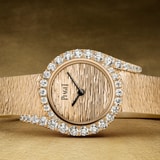
MAISON OF EXTRALEGANZA
A family of watchmakers lives high in the Swiss mountains, surrounded by green pastures in summer and a blanket of white in winter. Somehow, out of the confines and limited palette of those surroundings, the Piaget family conjures up a world of intense colour, audacious innovation and exceptional craftsmanship.
In 1874, Georges-Édouard Piaget used the long winter months in La Côte-aux-Fées to manufacture watch movements. He distinguished himself early on in creating ultra-thin escapements of exceptional quality and precision, and ended up working for some of the biggest names in watchmaking at the time. His approach, aptly summed up in his motto, “Always do better than necessary”, laid the foundations for what was to follow.

Now come the mid-20th century, and at the helm of a trademarked brand in its own right, Georges-Edouard’s grandsons Gerald and Valentin developed the business, from La Côte-Aux-Fées to La Côte d’Azur. Gerald travelled the world spreading the word and reach of Piaget, while Valentin’s imagination fired with new ways to distinguish Piaget as a watchmaker.

In 1957, Piaget announced its commitment to precious metals. From now on, it would only create watches in platinum and gold. Against a backdrop of competitors who were focused on the practicalities of the sports watch emerging at the time, this was a bold statement.
Its seclusion in the Jura mountains meant that the company had long been self-sufficient in terms of developing a full complement of in-house resources, including after in Geneva its own gold foundry and highly skilled teams of watchmakers, goldsmiths, stone cutters and engravers.
Piaget’s first High Jewellery creations in 1959 championed the playfulness of asymmetry and mixed stone cuts. Movement was a Piaget hallmark even then. The house harnessed the malleability of gold to its own creative ends, creating sensuous masterpieces that moulded to the neck and wrist like the ribbon in a couturier’s bow, moving freely with the wearer.

Coinciding with the step into these new creative waters, Piaget opened its first boutique in Geneva in June 1959. Its watches were already being sold around the world but this was a chance to celebrate its unique spin on creativity, both in high watchmaking and high jewellery, in one uniquely designed location. By way of contrast with the historical buildings lining the streets of the lakeside city, it was a statement of modernity.

The same team behind these creations mixed with clients who were rejecting the staid fashions of the past, and seeking a new glamour that combined modernity and colour. Thus in 1966, Piaget unveiled its first ornemental dial watches.
The deep cobalt blue of lapis lazuli, the rich veining of malachite contrasted with the dancing shimmer of a gold that was woven like chainmail. Heightening the overall effect was Piaget’s development of its very own Palace Decor technique. With its roots in the tradition of guilloché engraving, which had been used for centuries to enrich watch dials, Piaget liberated the technique from beyond the confines of the dial and began to engrave its tightly woven gold bracelets to form rich, densely textured patterns that mimicked nature patterns, such as bark, fur or frost.
At the same time Piaget revolutionised watch advertising with its bold campaigns for the 21st Century Collection in Vogue and Harper’s Bazaar. These were the result of a creative collaboration with Alberto Rizzo, the Italian photographer and artist, who was rethinking the way the world saw fashion photography.


Gerald’s son Yves joined the business in the 1960s. Despite being trained as a watch engineer and later as a gemmologist, artistry and the handmade remained his first loves. “We create watches, we don’t produce them,” he said. Yves was equally blessed with charisma and charm, and his love of travel meant that he spread the word of Piaget to the four corners of the earth, developing client relationships with some of the greatest figures of the 1970s and 1980s including Brooke Shields and Ursula Andress. It became his Piaget Society.
That attention to detail and level of symbiosis between creativity and the client experience led to the Style Selector. This innovative launch at the Piaget boutique in the heart of Manhattan meant that clients, like watch lover Andy Warhol, could create their own custom design, selecting the shape of their watch case, the type of dial and bracelet and the extent of the gem setting.



Our Creations












